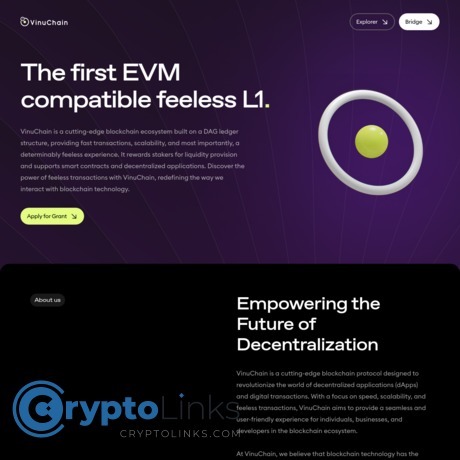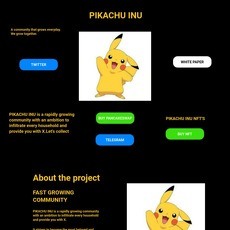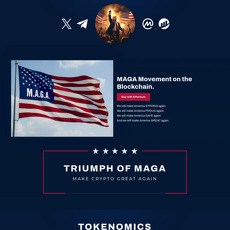VinuChain Review
VinuChain
vinuchain.org
If your website is on the scam list and you think that you are not a scammer, contact us. After you provide us with all the proof that you are in Crypto World with good intentions, we will delist you. Usually, you get in this category because you are hiding your team, you have a bad reputation(you are tricking, deceiving, scamming people), and you haven't got a written project whitepaper or is a shitty one....
Their Official site text:
Abstract
VinuChain, spearheaded by Vinu Ltd, represents a fresh take on the proven Fantom blockchain protocol. Holding onto the underpinnings of Fantom – speed, scalability, and security – VinuChain introduces an innovative mechanism known as the Quota System. This progressive feature marks a step forward in the blockchain domain, offering a stake-dependent, feeless transaction model.
The Quota System fuels the Determinably Feeless ethos of VinuChain, enabling holders of the native VinuChain coin (VC) to carry out a quota of feeless transactions in line with their stake. This framework presents a flexible and equitable method for managing transaction costs within the blockchain network.
Staying true to the principles of decentralization, VinuChain combines an efficient consensus mechanism and high transaction speed with an innovative fee model. The outcome is a platform designed to cater to a diverse portfolio of applications, ranging from microtransactions and gamified experiences to comprehensive DeFi applications.
Addressing the prevalent issue of transaction fees in blockchain ecosystems, VinuChain sets its sights on making the blockchain environment more streamlined, accessible, cost-effective, and user-friendly. Through these efforts, it aims to boost the adoption of blockchain technology in everyday life.
Keywords: VinuChain, Fantom blockchain protocol, Quota System, stake-dependent, feeless transactions, Determinably Feeless, decentralization, consensus mechanism, transaction speed, innovative fee structure, microtransactions, gamified experiences, DeFi applications, blockchain technology adoption.
Introduction
In the landscape of blockchain technology, transaction fees have been an integral yet controversial aspect. While necessary for the network's upkeep and security, they often act as a barrier to the integration of blockchain in everyday life, particularly in applications involving microtransactions or gamified experiences. VinuChain, developed by Vinu Ltd, emerges as a solution to this universal challenge.
VinuChain is a unique fork of the Fantom blockchain protocol, designed to uphold the core advantages of its predecessor, including security, speed, and scalability, while introducing an innovative stake-based feeless transaction model, known as the Quota System.
The Quota System allows stakers of VinuChain's native token (VC) to access a specific quota of feeless transactions based on their stake amount. The new system ensures equitable distribution of transaction capabilities while eliminating direct transaction costs for stakeholders. It also offers non-stakers the flexibility to conduct transactions traditionally, paying the gas fees, thereby accommodating diverse user preferences within the network.
In addition, the Quota System integrates an inflation mechanism on VC to fund the cash-back to stakers, effectively making it a self-sustaining model. This system not only minimizes the friction associated with fees, but also opens the door to a range of real-world use-cases such as microtransactions, gamified experiences, and a more cost-effective DeFi landscape. With this innovative solution, VinuChain aspires to revolutionize the blockchain environment, making it more accessible, efficient, and user-friendly for all.
Background
Blockchain technology, a cornerstone of the digital transaction revolution, has paved the way for decentralized finance (DeFi), smart contracts, and systems free from reliance on trust. Its capacity for ensuring transparency, security, and immutability has significantly impacted a multitude of sectors, spawning a wave of innovative solutions. Despite the transformative potential of blockchain, certain challenges hinder its broader acceptance. A key issue in this context is the unpredictability and sometimes excessive cost associated with transaction fees.
Traditionally, blockchain networks adhere to a fee model whereby users compensate validators (or miners) for processing their transactions. These fees serve to incentivize validators to uphold the network's security and integrity. However, due to their variable nature, influenced by factors like network congestion, transaction fees can result in elevated costs, leading to friction for users. This issue becomes particularly problematic in cases involving microtransactions or high-frequency trading, where the aggregate fees might exceed the value being transacted.
In an attempt to surmount this hurdle, VinuChain introduces a groundbreaking solution: a quota system contingent on staked assets. Building on the foundational principles of blockchain technology, VinuChain presents a model that offers feeless transactions to staking users. This approach allows VinuChain to preserve the incentive structure required for validators to secure the network while simultaneously providing a cost-effective solution for users, notably in microtransaction scenarios.
Crucially, VinuChain doesn't dispense with the conventional fee model entirely. Users who choose not to stake, or who surpass their daily quota, can still execute transactions by paying fees. This two-pronged model ensures the network's inclusivity, catering to a variety of user preferences and situations.
This document further delves into VinuChain's mechanisms, architecture, and token economics to illustrate how this balanced approach addresses the present challenges in blockchain technology. By offering both traditional and quota-based fee models, VinuChain holds the potential to foster wider adoption and spur innovation within the blockchain ecosystem.
VinuChain Protocol
3.1 Directed Acyclic Graph Architecture
VinuChain is a novel blockchain protocol that has been designed as a fork of the Fantom Protocol with enhancements. It employs the same underlying Directed Acyclic Graph (DAG) architecture with the unique enhancement of a Quota System.
In a DAG-based architecture, transactions are processed asynchronously, with each new transaction being linked to previous ones, forming a non-linear network of interconnected transactions. This structural design allows for high scalability and faster transaction speed, as transactions can be processed in parallel instead of sequentially.
3.2 Lachesis Protocol and ECC
VinuChain, like Fantom, uses the Lachesis protocol for its consensus mechanism, which supports smart contracts and enables a high transaction speed, ensuring security and scalability. The Lachesis protocol uses Elliptic Curve Cryptography (ECC) to secure transactions and assure authenticity.
3.3 Quota System
In contrast to Fantom, VinuChain introduces a Quota System, a unique mechanism that allows for feeless transactions for stakers. This Quota System is a separate layer atop the underlying consensus mechanism and does not directly influence the consensus process. Staking VC in VinuChain reserves transaction quota for the stakers, enabling them to conduct transactions without paying any gas fees, up to their quota limit. Furthermore, an innovative cash-back mechanism is implemented where an inflation on the native token (VC) funds the cash-back to stakers.
This architectural design choice offers two major benefits. Firstly, it allows users who can stake VC to conduct transactions without worrying about gas fees, making microtransactions viable and promoting broader network usage. Secondly, it adds a layer of incentive for users to hold and stake VC, indirectly promoting network security by increasing the staked supply.
We will further elaborate on the unique Quota System (Section 5) and the consensus mechanism (Section 4). It is important to note, however, that while the Quota System and Consensus Mechanism both serve pivotal roles in the functioning of VinuChain, they operate independently of each other; the Quota System is not a part of the Consensus Mechanism.
Consensus Mechanism
4.1 Lachesis Protocol and Event Blocks
VinuChain employs a consensus mechanism based on the Lachesis Protocol, similar to that used by Fantom. The Lachesis Protocol utilizes Byzantine Fault Tolerance (BFT) consensus combined with the unique topological ordering of the OPERA Chain. This approach results in rapid consensus times.
This mechanism works through the generation of event blocks, each containing new transactions or other data. These blocks are confirmed as part of the network’s consensus and are added to the OPERA Chain. Every event block is interconnected, forming an extensive chain of blocks with their respective transaction chains processed in parallel. This unique structure results in quick processing times and the capability to handle a high volume of transactions.
4.2 Reward and Incentive Structures
One key distinction between VinuChain and Fantom lies in the reward structure for network participants. In Fantom, delegators to nodes receive direct rewards for their delegation. In VinuChain, however, the reward is not linked to the consensus mechanism itself. Instead, users are rewarded indirectly through the quota system, which provides gas cash-backs for the staked VC tokens.
One significant benefit of this approach is the potential reduction in the minimum amount of VC tokens required to become a Validator. By lowering this threshold, we anticipate a broader participation in the network's operation, fostering a more decentralized structure. This democratization of validation aligns with one of the key principles of blockchain technology: decentralization.
The Validators on the VinuChain network are incentivized not only by block rewards but also through earning gas fees from transactions processed by non-stakers. This incentive model aims to encourage Validators to continue their crucial role in securing the network, thereby contributing to the ongoing stability and robustness of VinuChain.
4.3 Enhanced Security Measures
The Lachesis Consensus protocol, integral to this mechanism, uses Elliptic Curve Encryption Technology (ECC) for signing and verifying messages within the network. This technology enhances the security measures and ensures the integrity of all transactions processed within the network.
For a more detailed insight into the workings of this mechanism, readers are encouraged to refer to the in-depth description of the Lachesis Consensus protocol available at .
4.4 Byzantine Fault Tolerance
Lachesis operates on a Byzantine Fault Tolerance (BFT) consensus mechanism, an algorithm well-suited to defend against adversarial attacks. By design, BFT can sustain the operations of a network even if a portion of its nodes behaves maliciously or becomes unresponsive. In the context of VinuChain, as long as less than one-third of the validators are faulty or malicious, the system continues to function correctly and reach consensus.
4.5 Resistance to Sybil and Double Spend Attacks
The Lachesis protocol used in the VinuChain network enhances the speed, security, and scalability of blockchain transactions. However, equally important to the functioning of a blockchain network is its ability to withstand and respond to potential attacks. VinuChain, leveraging the innate properties of the Lachesis protocol, has an inherent mechanism to tackle these challenges.
One type of attack that the Lachesis protocol successfully defends against is the Sybil attack. In a Sybil attack, a malicious actor attempts to control the network by creating a large number of pseudonymous identities to gain a disproportionate influence. The Lachesis protocol mitigates this risk by associating a 'weight' with each node based on the amount of VC token staked. This staking mechanism ensures that an attacker would need to control a significant portion of the total VC tokens to launch a successful attack, which would be prohibitively expensive and impractical.
Another strength of the Lachesis protocol is its resistance to Double Spending attacks. In this type of attack, a malicious actor attempts to spend the same amount of cryptocurrency more than once. The asynchronous nature of the Lachesis protocol means that transactions are processed and confirmed in real-time, leaving a small window for a double-spending attempt. Furthermore, the Byzantine fault tolerance of the protocol guarantees that as long as the majority of the network's nodes are not compromised, such attacks are successfully averted.
4.6 Future Security Challenges
The Lachesis protocol’s robustness, coupled with the use of Elliptic Curve Encryption Technology (ECC), ensures that VinuChain is well-equipped to resist and respond to various network attacks. The network's design takes into account both the present landscape of blockchain security and future potential challenges, ensuring a dynamic, scalable, and secure network capable of providing feeless transactions.













